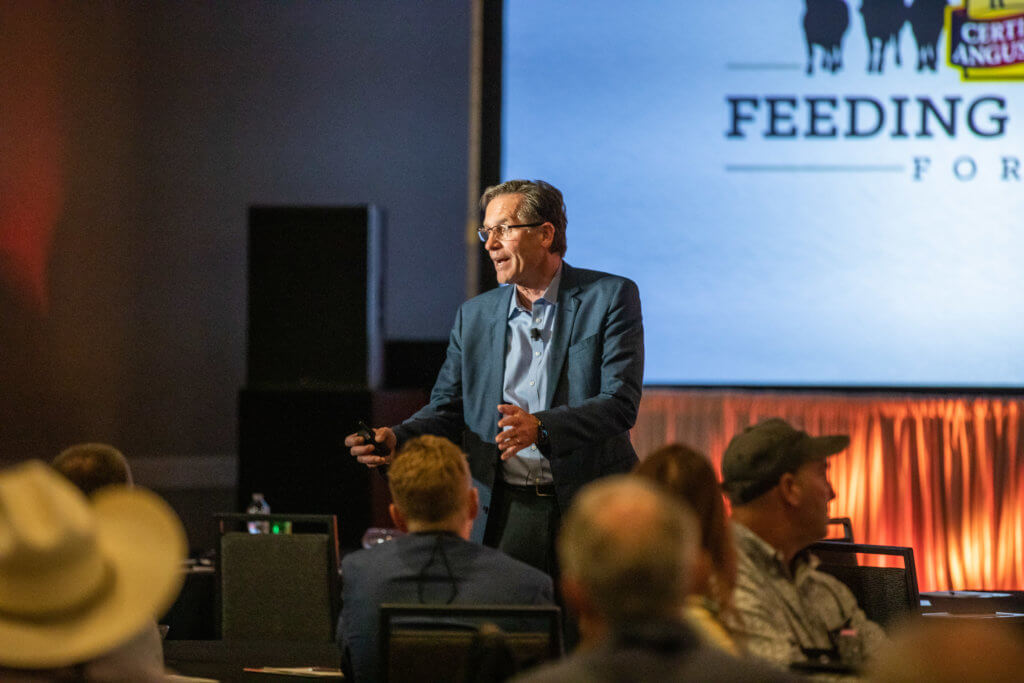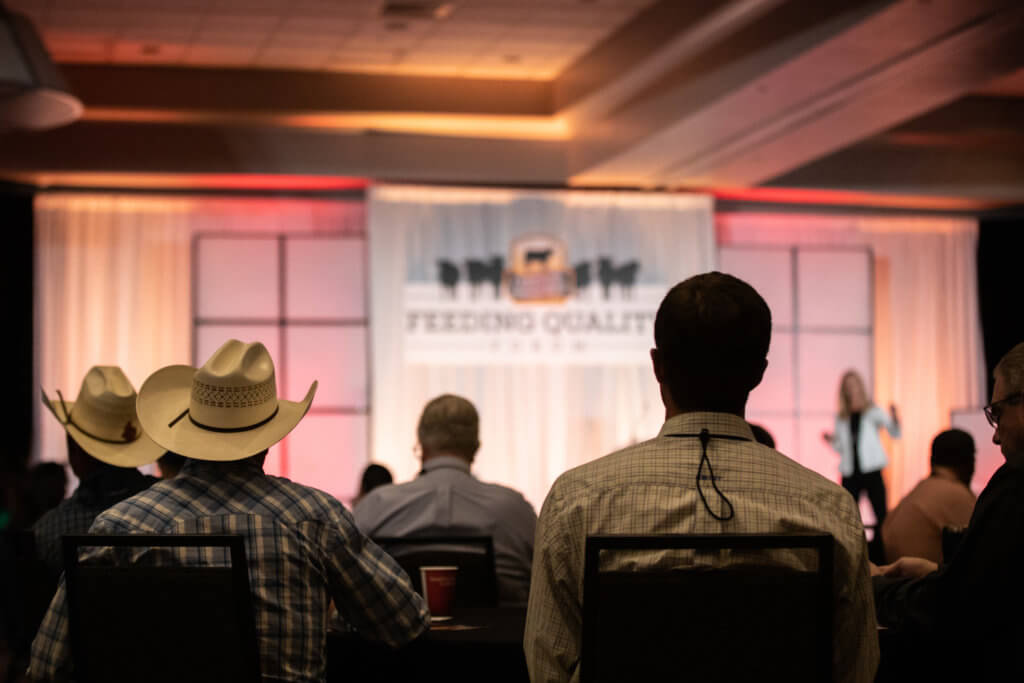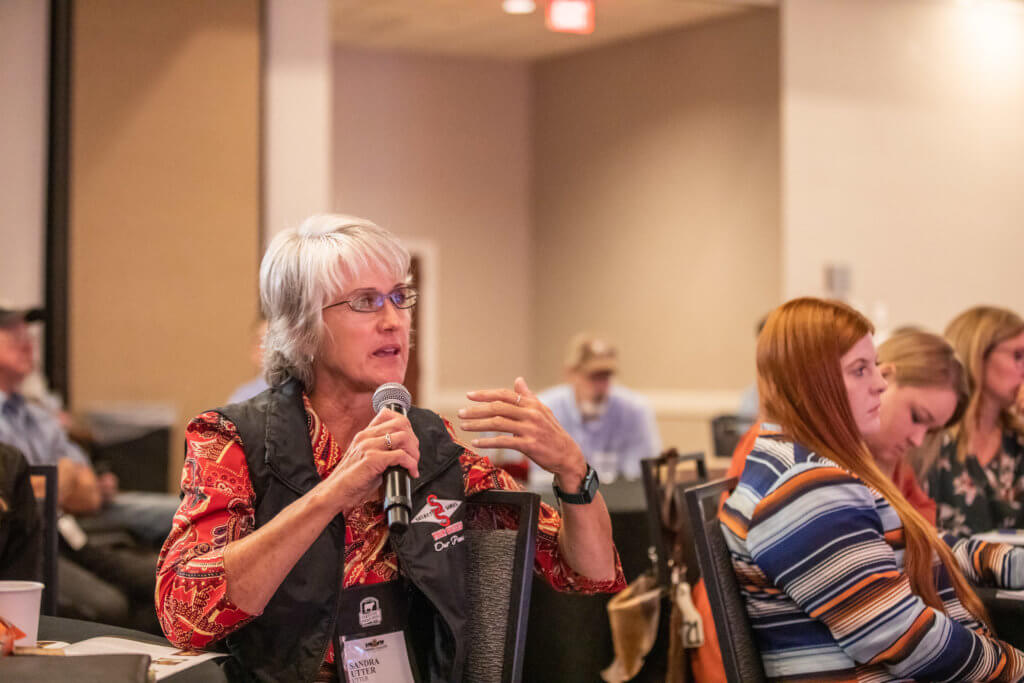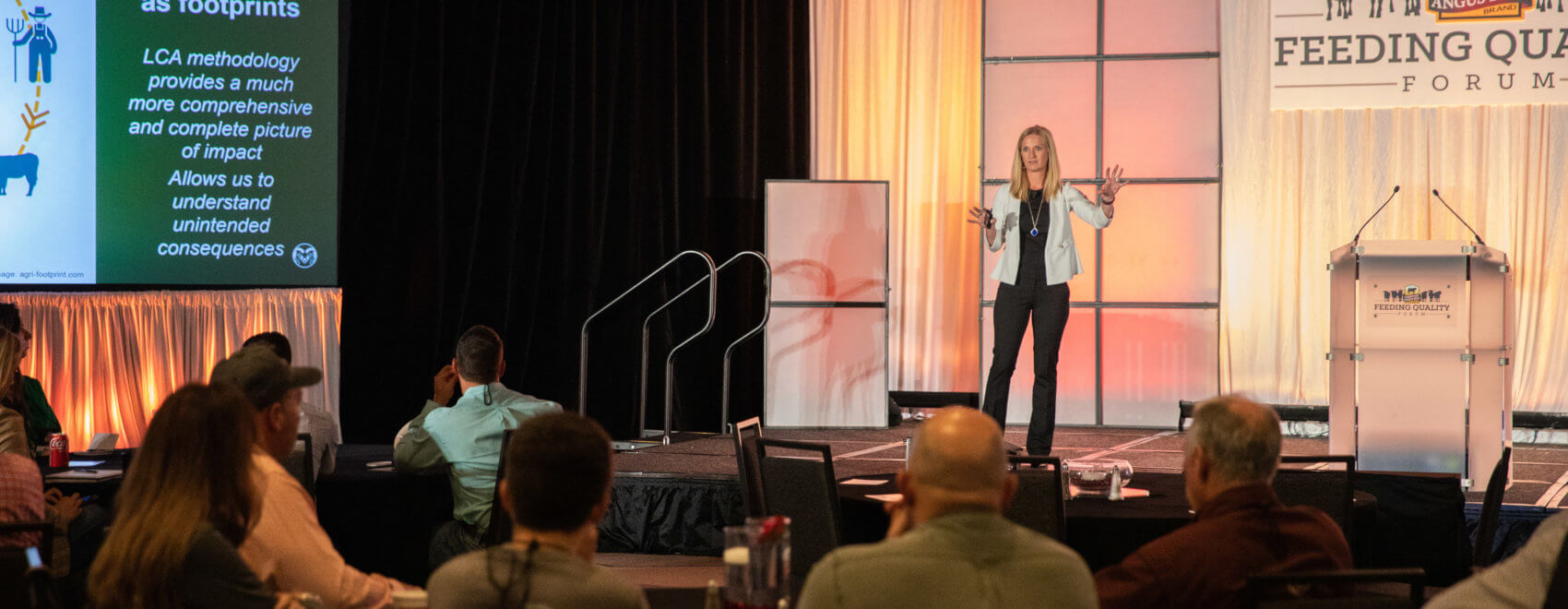Feeding Quality Forum shares perspective on future demands.
Story and photos by Morgan Boecker

Years of progress in efficiency and genetics may not be enough to satisfy the demands put on cattle producers moving forward.
That was the message from speakers at the 2021 Feeding Quality Forum, hosted by Certified Angus Beef (CAB) Aug. 24 to 25 in Fort Collins, Colo. They say there’s more demand for beef than ever, new challenges, too.
Sustainability
Sustainable beef production was at the forefront of conversations, with a caveat: emotion and science are on equal footing, noted Kim Stackhouse-Lawson, director of AgNext at Colorado State University (CSU). Data concludes beef can be a sustainable product, but often consumers are faced with a polarizing narrative that challenges their values and emotions towards animals. “Emotion wins every time” when it comes to a food brand, she said.
“The beef industry still has an incredible story to tell from an impact on a product-produced basis,” she shared. “But we’re starting to lose control of that narrative because overall emissions are still increasing.”
Stackhouse-Lawson said livestock’s contribution to total U.S. greenhouse gas emissions (GHG) is only 3.8%. But that’s up 20.7% since 1990.
This evolving landscape of customer expectations directs regulatory changes. It’s why JBS joined other beef processing companies and announced a climate goal to reach global Net Zero GHG emissions by 2040.
“This wasn’t just an idea on a whim of something that we wanted to do,” said Nikki Richardson, head of communications for JBS USA. “I think that the sky is the limit when it comes to identifying ways to have collaborative projects and things in place where we’re benefiting producers and ultimately getting closer to reach our goal.”
The ambitious goal will require working together.
For now, Stackhouse-Lawson said cattlemen should focus on land management and improving efficiencies around performance.
Technology gives producers that opportunity, said Justin Sexten, strategic and product lead for Performance Livestock Analytics, a part of Zoetis.
When managing more than one pen, not one single animal represents the average, yet decisions are made in groups to increase average performance.
From a sustainability perspective, some cattle in a pen may need additional resources. However, in most cases all animals receive the same resources, whether or not they’re needed.
“We have to find a way to manage from an individual perspective,” he said.

Global Impact
Dan Basse, president at AgResource Company, said China’s bout with African Swine Fever reduced that country’s pig population, and therefore more beef moved into the country. This year’s beef exports to China are at 10-year highs, despite exponentially higher costs to get it there.
Basse said managing feed costs will be difficult for beef producers. Severe drought challenges in the U.S., Russia, Brazil and Argentina have brought a shortage of corn in the world, even though world corn trade is still strong.
“I don’t think corn prices are going back to anything with a sub-five in front of it for the years to come,” Basse said.
On the bright side, beef demand is the highest in more than a decade. More disposable income, thanks to COVID-19 relief, means consumers are eating more beef.
“The long term for cattle looks really quite extraordinary and bullish for the next couple of years,” he said.
Beef Supply
If you’re on the sale side of that equation, more demand means higher prices. To those buying beef, that means it’s getting more difficult to source product.
“The customers think that we have printed menus that are disposable because of COVID,” said Dale Zimmerman, owner of two North Dakota restaurants. “It’s because we don’t know what we’re going to have in the cooler that day.”
Victoria Philips, president of Lombardi Brothers Meats, agreed: “Our biggest issue is definitely the supply.” Her business model is constantly shifting due to inconsistent supplies.
When restauranteurs cannot get their regular product, Philips and her team help them find beef and develop creative ways to apply it on menus. In many cases, price point is no longer the biggest obstacle, she said.
“Our job is to make sure we get the product restaurants need,” she said. “And that can change overnight.”


Changing Carcass Trends
Clint Walenciak, CAB director of product services, and Daniel Clark, CAB meat scientist, shared data from nearly eight million Angus-type fed cattle to see how increasing hot carcass weights (HCW) affect CAB acceptance.
“We see HCW at 40- to 50-pound swings to 70-pound or greater swings between those seasonal lows to seasonal highs,” Walenciak said, noting 20 pounds is a big adjustment within 12 months.
Black-hided cattle must meet 10 carcass specifications to qualify for the brand. The data revealed a positive trend between HCW and marbling, but also with ribeye size and backfat (the four CAB specifications most missed).
“When average fed cattle HCW gets above 900 pounds, we’re going to start kicking out more and more cattle,” Clark explained. “Below 850 pounds, then the cattle probably just aren’t reaching their genetic potential.”
The pandemic created a backlog of fed cattle where feedyards saw what happens when cattle have more days on feed, and consequently higher HCW. The use of feeding technologies, such as ractopamine, abruptly stopped for cattle with no guaranteed slaughter date.
That came with the unintended consequence of helping researchers answer questions cattle feeders otherwise may never have tested. Just feeding cattle longer can have the same response as feeding beta agonists for lean gain the last month of the feeding period.
Brad Johnson, meat scientist at Texas Tech University, shared survey results that ractopamine usage is not back to pre-pandemic levels and is not expected to return. In a future market with stricter requests, he warned not to give up on technology yet.
“I’m not just talking about implants,” Johnson said. “All technology, data management and maybe some natural feed additives that can improve marbling and reduce GHG emissions.”
The future will be about finding good relationships, sound science and sharing a story that resonates, said Keith Belk, CSU head of animal science department.
“You can’t do a good job of addressing industry issues with research or educating the next generation of students unless you have good partners to work with,” Belk said.
Visit CABcattle.com for more Feeding Quality Forum coverage.

